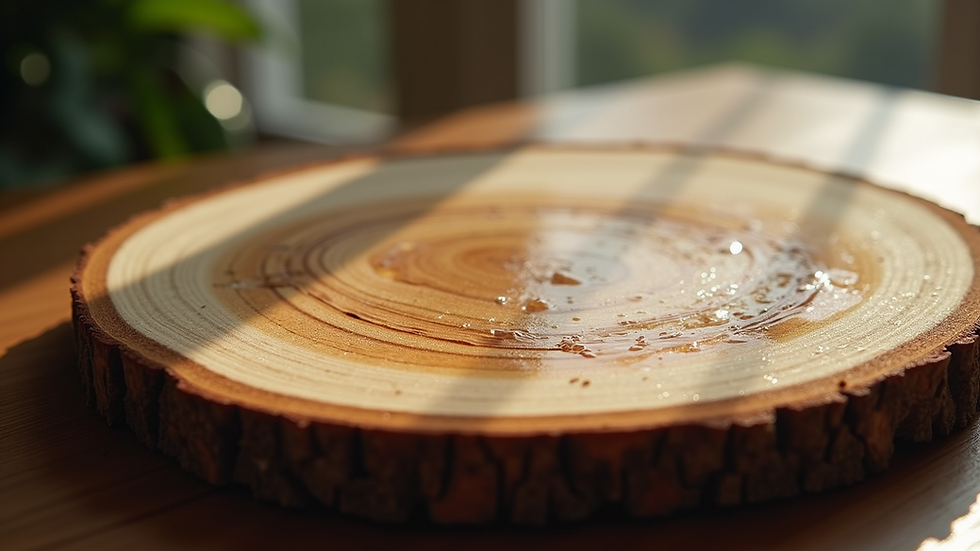Innovative Use of Wood Slices in Water Filtration: A Breakthrough in Bacteria and Microplastics Removal
- Jon Stevens
- Jul 23
- 3 min read
In today's world, the demand for clean water is critical. Pollution levels have surged, making contaminants like microplastics and harmful bacteria more prevalent. Innovative methods are emerging to tackle these pressing issues, and one of the most exciting is the use of wood slices as a filtration medium. This groundbreaking approach not only provides an affordable solution but also utilizes the natural properties of wood to cleanse water efficiently.
This article explores the latest research on wood slices in water filtration, detailing how they can effectively remove bacteria and microplastics. We will examine the mechanics of this process, discuss its environmental benefits, and consider its potential applications in various sectors.
Understanding the Problem: Bacteria and Microplastics in Water
Water contamination is a global crisis, with over 2 billion people lacking access to clean drinking water. Contaminants like bacteria can lead to serious illnesses, with diseases caused by waterborne pathogens resulting in approximately 485,000 deaths annually. At the same time, microplastics—tiny plastic particles that break down from larger plastic items—are now found in waterways worldwide.
Studying marine environments reveals that around 80% of seafood tested contains microplastics. As these particles work their way up the food chain, they pose serious health risks to humans. The interaction of bacteria and microplastics in our water supplies presents a serious challenge to ensure water safety and address the issue of persistent plastic pollution.
The Innovative Solution: Wood Slices as Filtration Media
Recent research demonstrates the potential of wood slices as a filtration system for removing bacteria and microplastics. Wood is a natural, readily available resource with unique features that aid in filtration. The porous structure allows it to trap particles, while its fibrous composition can foster beneficial microorganisms that degrade contaminants.
How Does It Work?
When contaminated water flows through a wood slice, larger particles are blocked by the wood fibers. The wood's natural properties enable it to adsorb smaller particles, including harmful microplastics.
Specifically, studies show that hardwood varieties, like oak, have enhanced filtration qualities due to their density and chemical characteristics that can inhibit bacterial growth.
The Science Behind the Process
The filtration mechanism involves both physical and biological methods. As water moves through the wood slice, larger bacteria are physically filtered out, while the surface of the wood supports microbial growth. These microorganisms can metabolize smaller bacteria and contaminants, effectively reducing their presence in the water.
In controlled studies, wood slice filtration has shown a 90% reduction in bacteria and a 75% decrease in microplastics within treated water. This dual-action strategy not only purifies water but also contributes to ecosystem regeneration.

Environmental Sustainability: A Natural Solution
The sustainability aspect of wood slice filtration is immense. This method requires minimal energy and relies on wood, a renewable resource.
Implementing wood slice technology can significantly reduce the need for chemical treatments and complex machinery often associated with traditional water purification. By utilizing natural materials, fewer pollutants are reintroduced into the environment, aligning with global sustainability goals.
Potential for Scalability
The flexibility of wood slice design means it can be easily scaled for various uses, from personal household filters to larger systems for community distribution. Such adaptability makes it an alluring option for regions battling water scarcity and contamination.
Applications in Various Sectors
The benefits of wood slice filtration extend far beyond personal use. Several industries stand to gain, including:
Agriculture: Clean water is essential for irrigating crops. Wood filtration can ensure that irrigation water is free from contaminants, helping to protect crops and maintain food safety.
Aquaculture: In fish farms, maintaining clean water is crucial. Implementing this filtration method can lead to healthier fish populations, which directly boosts productivity and income for farmers.
Municipal Water Treatment: Cities can adopt wood slice filtration in their treatment systems, enhancing existing methods while minimizing environmental impact.
Future Research and Developments
The research on wood slice filtration is still evolving. Key areas for future exploration include:
Optimizing Wood Types: Investigating which wood species maximize filtration efficiency.
Long-term Effectiveness: Understanding how wood performs under varying water volumes and contamination levels.
Enhancing Biological Activity: Finding ways to augment microbial growth on wood surfaces to boost contaminant breakdown.
A Promising Path Forward
The use of wood slices in water filtration represents an exciting development in the fight against the global water crisis. This innovative method not only decreases harmful bacteria and microplastics in water but also embodies a shift toward sustainable practices.
By harnessing nature's resources, we can uncover solutions to environmental challenges. Continued research and implementation of technologies like wood slice filtration can lead us toward a future where clean water is accessible for everyone, ensuring a healthier planet for generations to come.


Comments